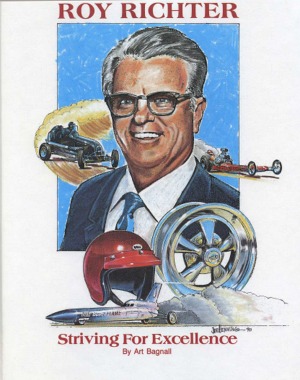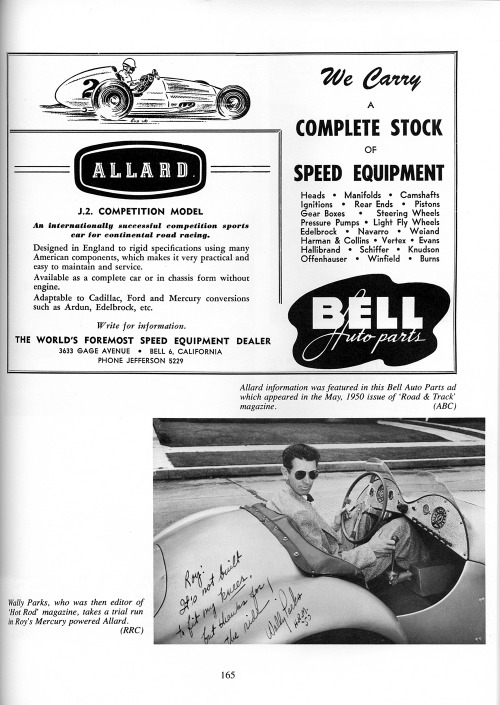Book Review - Roy Richter; Striving for Excellence
By

Roy Richter; Striving for Excellence
by Art Bagnall
Book review by Richard Parks, photographic consultant Roger Rohrdanz
Review By Richard Parks
 A book review is expected to explain the merits and demerits of a book and to let the reader decide if that book is worth adding to his library. This case is different. If you are a serious hot rodder who loves racing, then you must add this book to your collection. It is what we call a seminal reference, or a book that truly sets the new course and direction. Art Bagnall, the author, has simply researched and found the very roots of hot rodding in Southern California, and it centers around a place and a man that was pivotal to the hobby. If you want a reference book full of history then “Roy Richter; Striving for Excellence” must anchor your bookshelf. The book is quite impressive in size, scope, research and depth. It is a nice coffee table size at 9 by 11 inches with a hard cover, but lacking a book jacket. There are 15 chapters covering 379 pages, with a dedication and preface, followed by an acknowledgement to 117 people who helped Bagnall compile his masterpiece. Those acknowledged for their help and support comprise the very founders of the hot rodding movement in America. Wally Parks provided the introduction to the book. An epilogue, photo credits and list of employees who worked for Roy Richter is complete and informative.
A book review is expected to explain the merits and demerits of a book and to let the reader decide if that book is worth adding to his library. This case is different. If you are a serious hot rodder who loves racing, then you must add this book to your collection. It is what we call a seminal reference, or a book that truly sets the new course and direction. Art Bagnall, the author, has simply researched and found the very roots of hot rodding in Southern California, and it centers around a place and a man that was pivotal to the hobby. If you want a reference book full of history then “Roy Richter; Striving for Excellence” must anchor your bookshelf. The book is quite impressive in size, scope, research and depth. It is a nice coffee table size at 9 by 11 inches with a hard cover, but lacking a book jacket. There are 15 chapters covering 379 pages, with a dedication and preface, followed by an acknowledgement to 117 people who helped Bagnall compile his masterpiece. Those acknowledged for their help and support comprise the very founders of the hot rodding movement in America. Wally Parks provided the introduction to the book. An epilogue, photo credits and list of employees who worked for Roy Richter is complete and informative.
The book ends with an adequate four-page index and a history of the author. The index should have been twice the size in order to note everyone listed in the work, and is the only weakness in this book. Otherwise, Bagnall has created a masterpiece. There are 597 black and white photos representing the very earliest days of Bell Auto Parts and continuing into the modern era. There are no color photos, but the black and white photos do an exceptional job of telling the story of Roy Richter. In addition, there are 96 other presentations, such as posters, letters, drawings, and invoice orders to give further detail to the story. “Roy Richter; Striving for Excellence,” is published and written by Art Bagnall Publishing. Copies of the book are available from Jack Stewart, author of “The L.A. Roadsters, an Introspective.”
The book concerns Roy Richter, who played a pivotal role in automotive racing and hot rodding in the Southern California area from the 1930’s on, until his death in 1983. Richter is the theme for the book and the central character, but Richter would have been the first to tell you that he was fortunate to have the best hot rodders and racers around him from the beginning. Roy Richter purchased Bell Auto Parts from George Wight in the 1940’s. Wight was already an icon among street racers and those craving the action from their souped up gows and hot rods as far back as the 1920’s. Wight’s Bell Auto Parts store was one of the first places in the country where speed equipment was available. Wight teamed up with George Riley of the Riley 4-port fame to devise land speed racing events at Muroc Dry Lake in the Mojave Desert. These dry lake races were posted on a bulletin board at the shop on 3633 E. Gage Avenue, in Bell, California. If any place in the world can be called the mythic heart of hot rodding, Bell Auto Parts is that sacred spot. Richter, Roscoe Turner, Kenny Parks and others would work for this fabled speed equipment shop and go on to successes of their own. Wight and Riley would give up their land speed business, which would be absorbed by the SCTA (Southern California Timing Association). Other speed equipment shops would open to challenge the supremacy of Bell Auto Parts, such as Blair’s, So-Cal, Ansen and a host of speed equipment manufacturers. Wight would pass away in 1943 and Richter would buy the business and add Cragar Industries and Bell Helmets as subsidiaries.
Richter became the center for much of the racing and hot rodding in the 1940’s and ‘50’s. He was instrumental in the foundation of SEMA (Speed Equipment Manufacturers Association), which later changed their name to Specialty Equipment Manufacturers Association. The list of the early founders is impressive. Louie Senter joined with his Ansen Automotive. Ed “The Camfather” Iskenderian and Jim Deist from Deist Drag Chutes, were original members. Dean Moon, Vic Edelbrock, George Hurst, Chuck Potvin, Carroll Shelby, Harry Weber, Phil Weiand and many more of the early automotive greats were founding members of SEMA. But the center and heart of this prestigious group of men and women was Roy Richter. Richter would serve either as president or vice-president of the organization from 1963 until 1971. SEMA named him the Senior Board Advisor in 1972, a position specifically created for him by the other members to show their respect for the man who had worked so hard to bring professionalism and cooperation into a business that could best be described as cut-throat. The book details a long list of racers who owe their success to Roy Richter and Bell Auto Parts. Like Wight and Riley, Roy was at the center of the new and burgeoning sports that took wing in the early part of the 20th Century. Richter built his own midget racecars and they are quite sought after today. Richter built a miniaturized model rail track racecar in the late 1930’s. The Richter Streamliner was tethered to a pole and set the world 1/4 mile record of 68.38mph in 1940. A later version of these model-racing cars was called the Richter Bullet and is a very valuable collectible among collectors today.
Richter was also a master promoter and public relations talent. He understood the need to promote the different racing sports and was one of the first to subsidize racers with speed equipment. His own business was booming and he opened a MG/Morris/Austin foreign car import business with Thatcher Darwin in 1952. Bell Helmets would follow in 1954, and would prove to be a great part of the success that Richter enjoyed in the ’50’s. The helmets would find a ready market and prove to be a great safety factor in all motorsports racing. Cragar wheels crowned Richter’s business acumen. After Ak Miller’s stirring victory at the 1965 Pikes Peak Hill Climb, sales boomed. It is impossible to calculate the impact that Roy Richter and his companies had on hot rodding and motorsports racing over the decades. Open wheel racing, drag racing, stock car, midget and short track oval racing, Bonneville and land speed racing all owe Richter their gratitude for the constant sponsorship and help he has provided over the years. Art Bagnall has captured Roy Richter and his co-workers and friends with excellent photos and text. As you read this book you will come to understand just how much this man meant to all of us. Hot rodding is a sport created by thousands of men and women like Roy Richter. This is a book that will be the centerpiece of your library and one that you will consult often.
From the Book
 |
|
This page shows some prices for chassis and body parts |
 |
| This page has Wally Parks in Roy Richter’s Allard |
This book is out of print and hard to find, but there is still some used books on the internet at these sights. www.alibris.com, www.goodwillbooks.com, www.biblio.com
You can also e-mail Richard Parks at [email protected].
